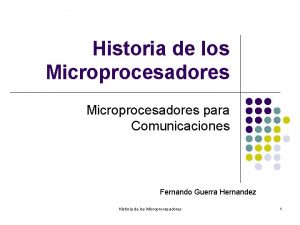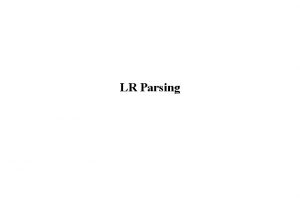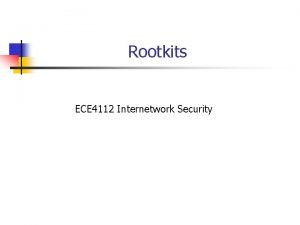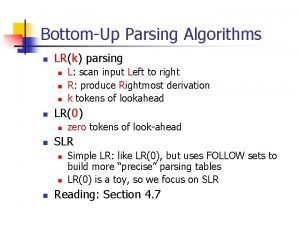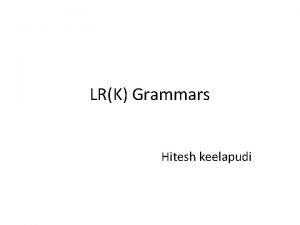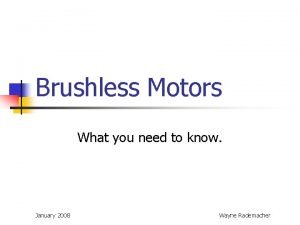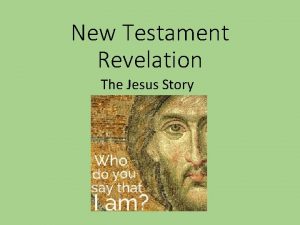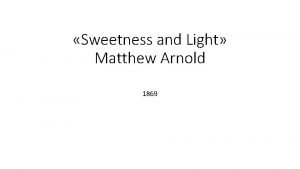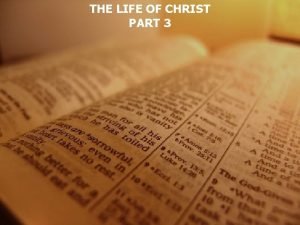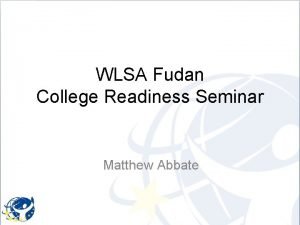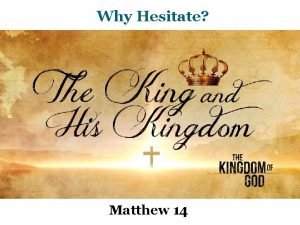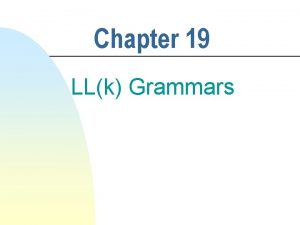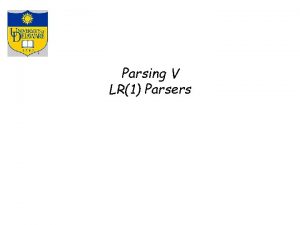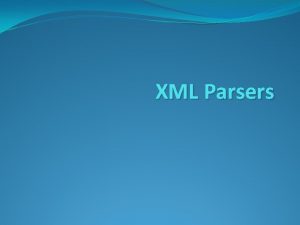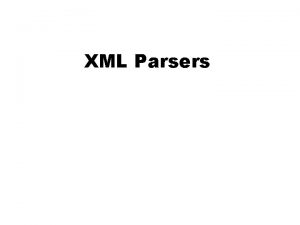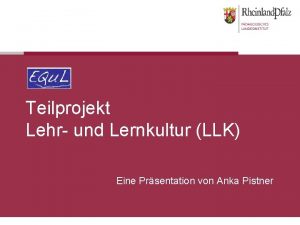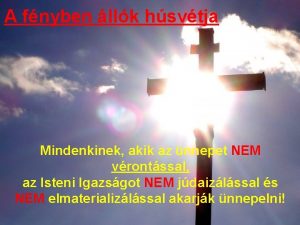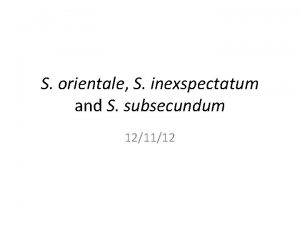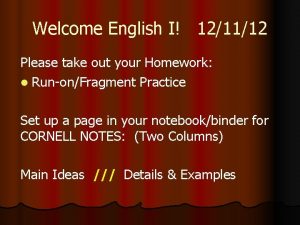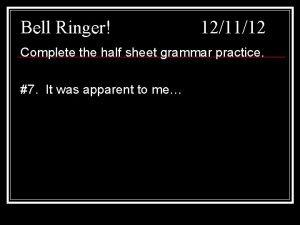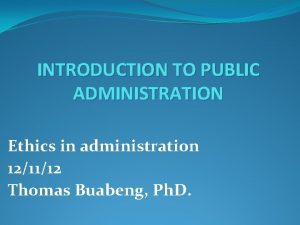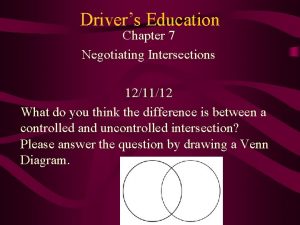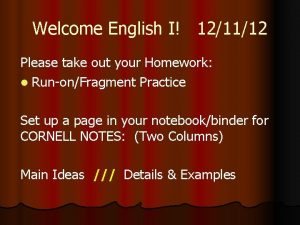LLk and LRk Parsers CS 6800 121112 Matthew


















- Slides: 18

LL(k) and LR(k) Parsers CS 6800 12/11/12 Matthew Rodgers

LL(k) and LR(k) What are LL and LR parsers? What grammars do they parse? What is the difference between LL and LR? Why do we care?

Top-Down vs. Bottom-Up Parsers Top-Down LL(k) parsers are Top. Down Parsers LL(1) is Deterministic The way you are most likely familiar with how to parsing grammars Bottom-Up LR(k) Parsers are Bottom -Up Parsers LR(k) Grammars is exactly the set of Deterministic Context. Free Grammars LR(k), for some k, is also LR(1)

Generalized LL Parser Consider the following ( grammar: o S→F o S → (S+F) S 2 ) a 1 o F→a Input: (a+a) The parsing table for this grammar is shown F 3 + $

LL Parser Cont. The stack initializes with the start symbol, S and is compared to the first symbol in the input Since it does not find an ( on the stack, it looks at the table to see which rule to apply After applying the rule, it attempts again It finds the ( in both the input string and the top of the stack ( S 2 F ) A + $ 1 3 The parser continues to do this until it reaches the end symbol, $, or rejects the string

LR(k) Given an LR(1) grammar, we can produce a shiftreduce parser table Shift– “Shifts” an input symbol onto the parser’s stack and builds a node in the parse tree labeled by that symbol Reduce– “Reduces” a string of symbols from the top of the stack to a non-terminal symbol using a grammar rule o When it does this it builds the piece of the parse tree However, many LR(1) languages have too large of a parse table to be practical Instead we use LALR parsing

Shift-Reduce Example S→S + E | E E → num | (S) Derivation Parse Stack Unparsed Input Action (1+(2+3)) ε (1+(2+3)) Shift (1+(2+3)) (1 +(2+3)) Reduce E→ num (E+(2+3)) (E +(2+3)) Reduce S→E (S+(2+3)) (S +(2+3)) Shift (S+(2+3)) (S+( 2+3)) Shift (S+(2+3)) (S+(2 +3)) Reduce E→ num (S+(E+3)) (S+(E +3)) Reduce S→E (S+(S+3)) (S+(S +3)) Shift (S+(S+3)) (S+(S+ 3)) Shift Etc.

Building an LR(0) Parser

Lets Build An LR(0) Parser! First we shall define a simple grammar o E→E*B o E→E+B o E→B o B→ 0 o B→ 1 We also add a new rule, S → E, which is used by the parser as a final accepting rule

Items To create a parsing table for this grammar we must introduce a special symbol, ∙, which indicates the current position for which the parser has already read symbols on the input and what to expect next E. g. E → E ∙ + B o This shows that the E has already been processed and the parser is looking for a + symbol next Each of these above rules is called an item There is an item for each position the dot symbol can take along the right-hand side of the rule

Item Sets Since a parser may not know which grammar rule to use in advance, when creating our table we must use sets of items to consider all the possibilities E. g. o S→ • E o E→ • E*B o E→ • E+B o E→ • B o B→ • 0 o B→ • 1 The first line is the initial rule for the item set, but since we need to consider all possibilities when we come to a nonterminal, we must create a closure around the non-terminal E, in this case. (By extension, we must do the same for B as shown by the 5 th and 6 th items. )

Item Sets for Our Example Set 0 o S→ • E o E→ • E*B Set 2 o B→ 1 • Set 3 o E→ • E+B o S→ E • o E→ • B o E→ E • *B o B→ • 0 o E→ E • +B o B→ • 1 Set 1 o B→ 0 • Set 4 o E→ B •

Set 5 o E→ E* • B o B→ • 0 o B→ • 1 Set 6 o E→ E+ • B o B→ • 0 o B→ • 1 Set 7 o E→ E*B • Set 8 o E→ E+B •

Transition Portion of Parse Table Item Set * + 0 0 1 E B 1 2 3 4 5 1 2 7 6 1 2 8 1 2 3 5 6 4 7 8 Each of the transitions can be found by following the item sets to where the new item set is created from o Item Set 7 Spawned as a result of Item Set 5

Constructing the Table After finishing creating the item sets and the transitions, follow the steps below to finish the table 1) The columns for nonterminals are copied to the goto table. 2) The columns for the terminals are copied to the action table as shift actions. 3) An extra column for '$' (end of input) is added to the action table that contains acc for every item set that contains S → E • . 4) If an item set i contains an item of the form A → w • and A → w is rule m with m > 0 then the row for state i in the action table is completely filled with the reduce action rm.

Final Parse Table Action State * + 0 Goto 0 1 s 2 1 r 4 r 4 2 r 5 r 5 3 s 5 s 6 4 r 3 $ E B g 3 g 4 acc r 3 5 s 1 s 2 g 7 6 s 1 s 2 g 8 7 r 1 r 1 8 r 2 r 2

LALR Parsing “Lookahead” LR Parsing– Deterministic, shift-reduce parser Most practical (non-Natural) languages can be described by an LALR Parser tables are fairly small Yacc is a Parser-Generation tool that creates LALR parsers

References "LL Parser. " Wikipedia. Wikimedia Foundation, 11 Sept. 2012. Web. 12 Nov. 2012. <http: //en. wikipedia. org/wiki/LL_parser>. "LR Parser. " Wikipedia. Wikimedia Foundation, 11 July 2012. Web. 12 Nov. 2012. <http: //en. wikipedia. org/wiki/LR_parser>. Rich, Elaine. "Context-Free Parsing. " Automata, Computability and Complexity: Theory and Applications. Upper Saddle River, NJ: Pearson Prentice Hall, 2008. 323 -50. Print.
 Microprocesadores
Microprocesadores The most powerful parser is
The most powerful parser is Lrk v4 trojan
Lrk v4 trojan Lkm trojan
Lkm trojan Lrk e7
Lrk e7 Lr0
Lr0 Lrk winding
Lrk winding Matthew mark luke john acts romans song
Matthew mark luke john acts romans song Are matthew mark luke and john the same story
Are matthew mark luke and john the same story Sweetness and light by matthew arnold
Sweetness and light by matthew arnold Jesus forgives and heals a paralyzed man matthew
Jesus forgives and heals a paralyzed man matthew Matthew goniwe school of leadership
Matthew goniwe school of leadership Matthew 5 3-11
Matthew 5 3-11 Matthew mark luke and john prayer
Matthew mark luke and john prayer If you forgive those who sin against you
If you forgive those who sin against you Matthew mark luke and john prayer
Matthew mark luke and john prayer How did juda die
How did juda die Matthew abbate
Matthew abbate Matthew 14 v22-33
Matthew 14 v22-33
